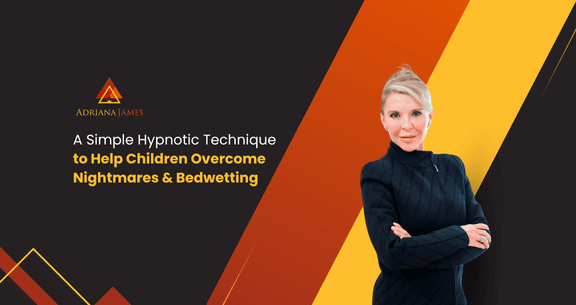If you haven’t read Part 1 and Part 2, they provide important context on how movies influence us and how to guard against it.
By Dr. Adriana James
In my last two articles, I explained how movies—and media in general—can affect us at the unconscious level. We talked about how they can install new beliefs and behaviors, sell us products we never thought we wanted, and even desensitize us to things that would normally make us uncomfortable.
We also explored how this influence happens: through suggestion, repeated exposure, and bypassing our critical thinking faculties.
Today, I want to give you something practical—a simple, time-tested hypnotic technique that you can use with children (and even adapt for yourself) to help with challenges like nightmares or bedwetting.
This method comes from the late Dave Elman, a brilliant and ethical hypnotherapist and medical doctor who was world-renowned in his field. I teach it in my Hypnosis Practitioner Trainings, and I’ve seen parents get remarkable results with it when applied exactly as instructed.
When and Why to Use This Technique
This approach is particularly useful for:
- Children who suffer from nightmares that disturb their sleep
- Children under about age 7 who still experience bedwetting
- Any situation where a behavioral change is needed, and the child is receptive to simple instructions
Why age 7? That’s about the time when a child begins to develop the critical faculty—the mental filter that separates fantasy from reality. Before that, children are essentially “little unconscious minds walking around,” absorbing everything directly without questioning it. This makes gentle, positive suggestions especially effective.
How to Apply the Technique
Here’s the step-by-step process exactly as I teach it.
- Wait until the child is in deep sleep
The goal is to bypass the critical faculty without waking the child. To know they are in deep sleep:
- Watch their breathing. It should be slow and steady—about 7 or 8 breaths per minute (even 6 or 7 is ideal).
- Be patient; if their sleep is too light, wait a little longer.
- Approach quietly and gently
You don’t want to startle them. Use a very soft, calm tone.
Say:
“This is your [mom/dad/grandma/etc.]. You can hear me, but you can’t wake up.”
Repeat this slowly and softly several times. Your aim is to maintain the deep sleep state while ensuring the unconscious mind is listening.
- Establish communication with the unconscious
Gently touch the child’s thumb or forefinger that’s easiest to access after you say the following:
“I know you’re hearing me when your [thumb/finger] that I’m going to touch begins to rise up. You can hear me but you can’t wake up. You can hear me but you stay deeply asleep.”
Repeat the phrase and soft touch until you see a tiny movement or twitch and the thumb/finger start to rise. This confirms you’ve connected with the unconscious mind.
- Give clear, positive suggestions
Once you see that response, offer the suggestion you want to install. For bedwetting, for example:
“When your bladder is full, you wake up and safely walk to the bathroom and pee in the toilet. After which you return safely to bed, you go back in bed and fall deeply asleep and you sleep very deeply until the morning when you wake up happy, refreshed and full of energy.”
Include the word “safely” to reinforce security and confidence. Repeat this suggestion several times, slowly and softly.
- Close the process
When you’re done, say:
“Now I’m going to stop talking to you. When I stop talking to you, you will revert to the state you were in before I started talking to you. You’ll sleep deeply, and in the morning you will awake and be completely refreshed. You won’t even remember I was talking to you, but you’ll feel great for having gone to the bathroom and coming to back to bed and sleeping soundly. And now I’m going to stop talking. Go to sleep. Sleep soundly and I’ll see you in the morning. I’ll stop talking now.”
We teach the Dave Elman method and other powerful hypnosis techniques in our 3-Day Hypnosis Training — perfect for parents, coaches, and professionals.
Important Guidelines
- Use my words exactly if you’re not trained in NLP or hypnotherapy. Every word you speak is a suggestion to the unconscious mind—choose carefully.
- Never replace medical advice with this technique. If your child has persistent behavioral or health concerns, always consult a licensed medical professional.
- Patience is key—you may need to repeat the process across several nights for full effect.
Why It Works
This method works because it speaks directly to the unconscious mind during a natural trance state—deep sleep. At that point, the conscious, analytical mind is “offline,” and positive suggestions are absorbed more readily.
It’s the same principle that makes children so receptive to influence from movies, advertising, and media—but here, we’re using it consciously, ethically, and positively.
Beyond Bedwetting and Nightmares
Although I’ve described this method for these two common issues, parents have reported success using it (carefully and appropriately) for other small behavioral shifts with children under 7.
If you are a trained hypnotherapist, you’ll already see how to adapt the approach for different situations. If not, keep it simple and always focused on one clear, positive outcome at a time.
The Takeaway
We can’t prevent our children—or ourselves—from encountering suggestions in daily life. But we can choose which suggestions take root.
By learning simple hypnotic techniques like this one, you can:
- Help your child overcome challenges gently and naturally
- Strengthen positive habits
- Build confidence and security
- Counteract negative suggestions from other sources
This concludes the 3-part series on how movies affect our minds. You can return to the hub page to revisit earlier parts
If you’d like to learn this and other powerful techniques in depth, we teach them in our 3-Day Hypnosis Training and expand on them in Hypnosis Trainer’s Training. These courses are for anyone who wants to protect themselves from unwanted influence—and use the power of suggestion to create positive change.
Disclaimer: Remember to never replace medical advice with this technique. If your child has behavioral or health concerns, always consult a licensed medical professional.

